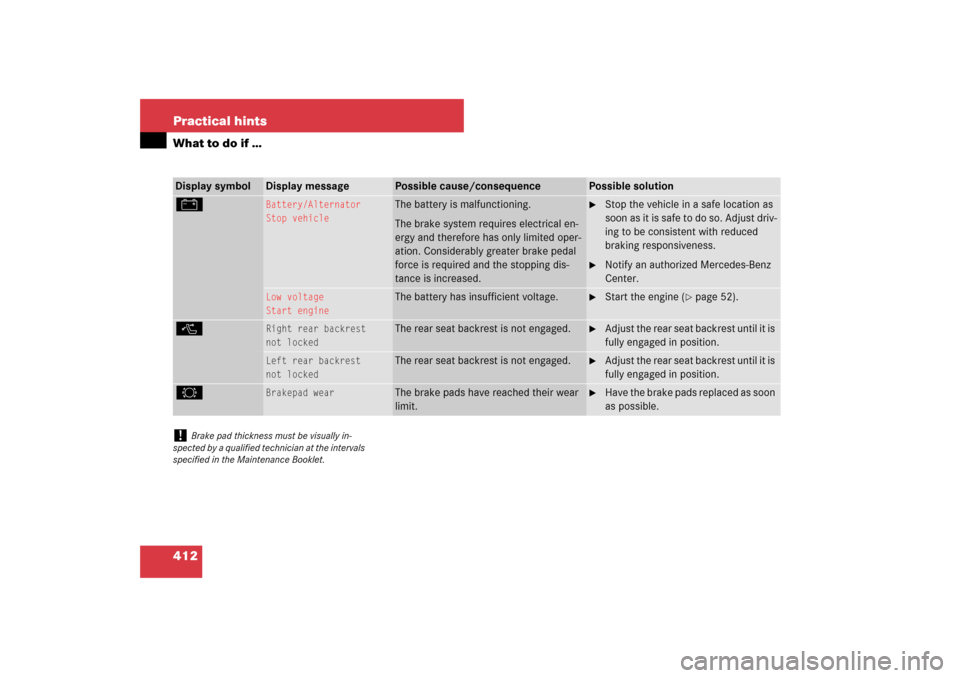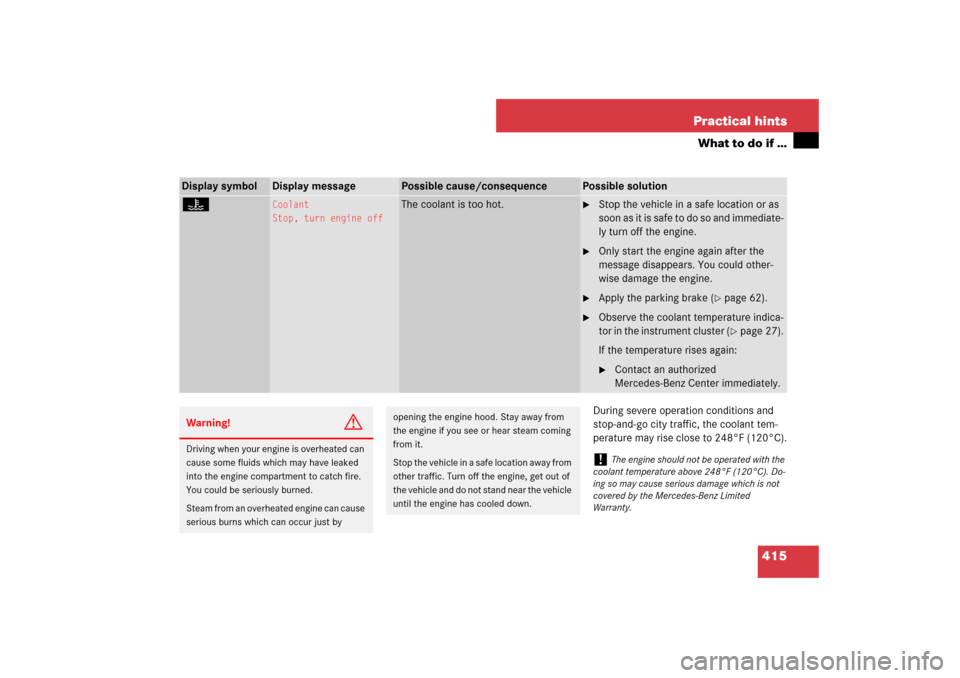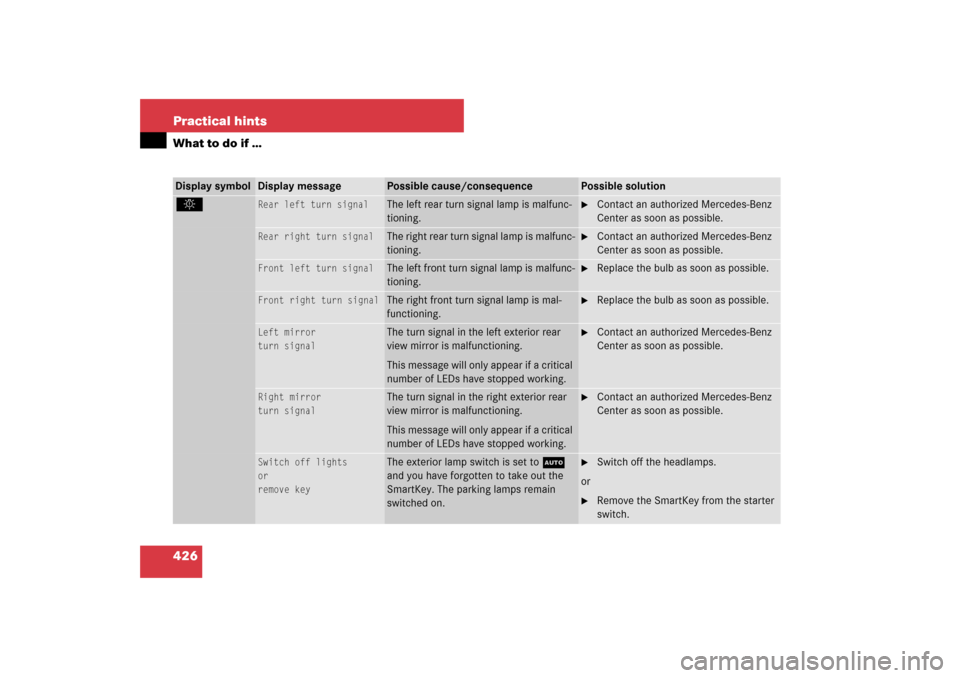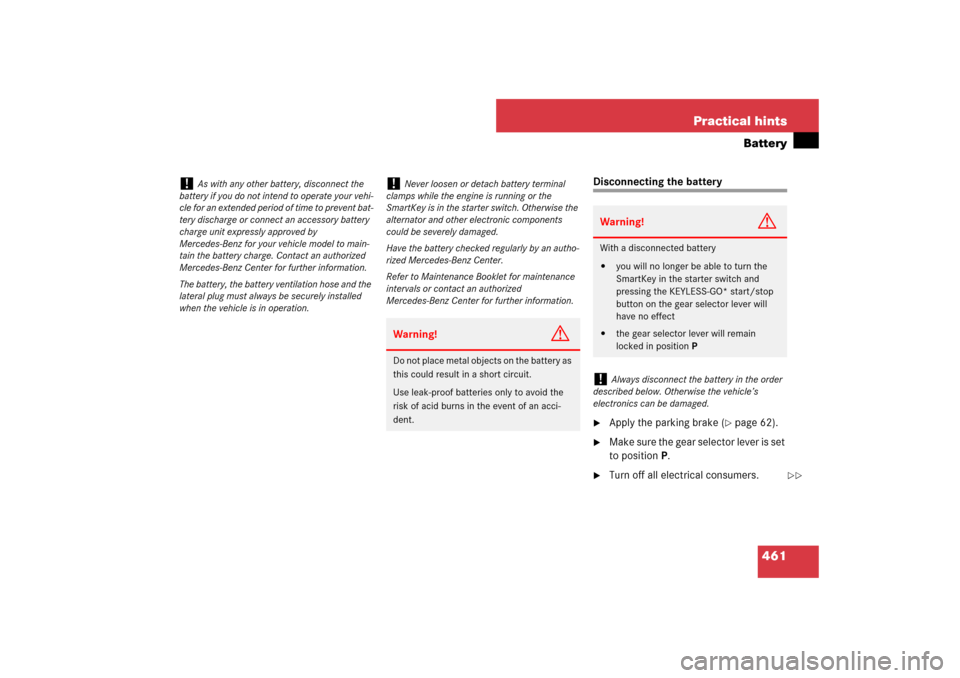Page 408 of 522

407 Practical hints
What to do if …
Display
Possible cause/consequence
Possible solution
P
Gear selector lever
in Park position
You have tried to start the engine with the
KEYLESS-GO* start/stop button with the
gear selector lever not in positionP.
�
Place the gear selector lever in
positionP.
You have tried to turn off the engine with the
KEYLESS-GO* start/stop button with the
gear selector lever not in positionP.
P/N
Shift gear select. lever
to Neutral or Park
You have tried to start the engine with the
KEYLESS-GO* start/stop button while the
gear selector lever was in positionR orD.
�
Place the gear selector lever in positionP
orN. Make sure the brake pedal is de-
pressed.
PRE-SAFE
inoperative
See Operator’s Man.
PRE-SAFE
® itself has failed. All other occu-
pant safety systems, such as the air bags, are
still available.
�
Visit an authorized Mercedes-Benz Cen-
ter as soon as possible.
If ESP
® and PRE-SAFE
® malfunction messag-
es are displayed simultaneously, PRE-SAFE
®
has been deactivated as a result of these
malfunctions. All other occupant safety sys-
tems, such as the air bags, are still available.
Page 413 of 522

412 Practical hintsWhat to do if …Display symbol
Display message
Possible cause/consequence
Possible solution
#
Battery/Alternator
Stop vehicle
The battery is malfunctioning.
The brake system requires electrical en-
ergy and therefore has only limited oper-
ation. Considerably greater brake pedal
force is required and the stopping dis-
tance is increased.
�
Stop the vehicle in a safe location as
soon as it is safe to do so. Adjust driv-
ing to be consistent with reduced
braking responsiveness.
�
Notify an authorized Mercedes-Benz
Center.
Low voltage
Start engine
The battery has insufficient voltage.
�
Start the engine (
�page 52).
(
Right rear backrest
not locked
The rear seat backrest is not engaged.
�
Adjust the rear seat backrest until it is
fully engaged in position.
Left rear backrest
not locked
The rear seat backrest is not engaged.
�
Adjust the rear seat backrest until it is
fully engaged in position.
2
Brakepad wear
The brake pads have reached their wear
limit.
�
Have the brake pads replaced as soon
as possible.
!
Brake pad thickness must be visually in-
spected by a qualified technician at the intervals
specified in the Maintenance Booklet.
Page 416 of 522

415 Practical hints
What to do if …
During severe operation conditions and
stop-and-go city traffic, the coolant tem-
perature may rise close to 248°F (120°C).
Display symbol
Display message
Possible cause/consequence
Possible solution
•
Coolant
Stop, turn engine off
The coolant is too hot.
�
Stop the vehicle in a safe location or as
soon as it is safe to do so and immediate-
ly turn off the engine.
�
Only start the engine again after the
message disappears. You could other-
wise damage the engine.
�
Apply the parking brake (
�page 62).
�
Observe the coolant temperature indica-
tor in the instrument cluster (
�page 27).
If the temperature rises again:
�
Contact an authorized
Mercedes-Benz Center immediately.
Warning!
G
Driving when your engine is overheated can
cause some fluids which may have leaked
into the engine compartment to catch fire.
You could be seriously burned.
Steam from an overheated engine can cause
serious burns which can occur just by
opening the engine hood. Stay away from
the engine if you see or hear steam coming
from it.
Stop the vehicle in a safe location away from
other traffic. Turn off the engine, get out of
the vehicle and do not stand near the vehicle
until the engine has cooled down.
!
The engine should not be operated with the
coolant temperature above 248°F (120°C). Do-
ing so may cause serious damage which is not
covered by the Mercedes-Benz Limited
Warranty.
Page 422 of 522
421 Practical hints
What to do if …
Display symbol
Display message
Possible cause/consequence
Possible solution
F
Change
key batteries
The SmartKey with KEYLESS-GO* batter-
ies are discharged.
�
Replace the batteries (
�page 441).
Key
not recognized
The SmartKey with KEYLESS-GO* is not
recognized while the engine is running
because�
the SmartKey with KEYLESS-GO* is
not in the vehicle
�
there is strong radio-frequency inter-
ference
�
Stop the vehicle as soon as it is safe
to do so.
�
Search for the SmartKey with
KEYLESS-GO*.
Otherwise the vehicle cannot be cen-
trally locked nor can the engine be
started again after the engine is
stopped.
Key
not recognized
The SmartKey with KEYLESS-GO* is mo-
mentarily not recognized.
�
Change the position of the SmartKey
in the vehicle.
�
Operate the vehicle with the
SmartKey in the starter switch if nec-
essary.
Page 427 of 522

426 Practical hintsWhat to do if …Display symbol
Display message
Possible cause/consequence
Possible solution
.
Rear left turn signal
The left rear turn signal lamp is malfunc-
tioning.
�
Contact an authorized Mercedes-Benz
Center as soon as possible.
Rear right turn signal
The right rear turn signal lamp is malfunc-
tioning.
�
Contact an authorized Mercedes-Benz
Center as soon as possible.
Front left turn signal
The left front turn signal lamp is malfunc-
tioning.
�
Replace the bulb as soon as possible.
Front right turn signal
The right front turn signal lamp is mal-
functioning.
�
Replace the bulb as soon as possible.
Left mirror
turn signal
The turn signal in the left exterior rear
view mirror is malfunctioning.
This message will only appear if a critical
number of LEDs have stopped working.
�
Contact an authorized Mercedes-Benz
Center as soon as possible.
Right mirror
turn signal
The turn signal in the right exterior rear
view mirror is malfunctioning.
This message will only appear if a critical
number of LEDs have stopped working.
�
Contact an authorized Mercedes-Benz
Center as soon as possible.
Switch off lights
or
remove key
The exterior lamp switch is set toU
and you have forgotten to take out the
SmartKey. The parking lamps remain
switched on.
�
Switch off the headlamps.
or
�
Remove the SmartKey from the starter
switch.
Page 437 of 522
436 Practical hintsUnlocking/locking in an emergencyUnlocking the vehicle
If you cannot unlock the vehicle with the
SmartKey or SmartKey with
KEYLESS-GO*, open the driver’s door and
the trunk using the mechanical key.
Removing the mechanical key
1Mechanical key locking tab
2Mechanical key
�
Move locking tab1 in direction of ar-
row.
�
Slide mechanical key2 out of the
housing.
Unlocking the driver’s door
�
Insert mechanical key2 into the
driver’s door lock until it stops.
�
Turn mechanical key2 counterclock-
wise to position1 until the locking
knobs move up.
The driver’s door is unlocked.
�
Pull door handle to open the driver’s
door.
i
Unlocking your vehicle with the mechanical
key and opening the driver’s door or the trunk
will trigger the anti-theft alarm system.
To cancel the alarm, Insert the SmartKey or
SmartKey with KEYLESS-GO* in the starter
switch.
1
Unlocking
2
Mechanical key
Page 453 of 522

452 Practical hintsFlat tirePreparing the vehicle�
Park the vehicle in a safe distance from
moving traffic on a hard, flat surface
when possible.
�
Turn on the hazard warning flasher
(�page 144).
�
Turn the steering wheel so that the
front wheels are in a straight ahead po-
sition.
�
Set the parking brake (
�page 62).
�
Move the gear selector lever toP.
Vehicles with SmartKey:
�
Turn off the engine (
�page 63).
�
Remove the SmartKey from the starter
switch.Vehicles with SmartKey with
KEYLESS-GO*:
�
Turn off the engine by pressing the
KEYLESS-GO* start/stop button on the
gear selector lever once (
�page 64).
�
Open the driver’s door (this puts the ig-
nition in position0, same as with the
SmartKey removed from the starter
switch). The driver’s door then can be
closed again.
�
Have any passenger exit the vehicle at
a safe distance from the roadway.
Mounting the spare wheel
i
Open door only when conditions are safe to
do so.
Warning!
G
The dimensions of the spare wheel
(Minispare or collapsible tire) are different
from those of the road wheels. As a result,
the vehicle handling characteristics change
when driving with a spare wheel mounted.
Adapt your driving style accordingly.
The spare wheel is for temporary use only.
When driving with spare wheel mounted,
ensure proper tire pressure and do not ex-
ceed a vehicle speed of 50 mph (80 km/h).
Drive to the nearest Mercedes-Benz Center
as soon as possible to have the spare wheel
replaced with a regular road wheel.
Never operate the vehicle with more than
one spare wheel mounted.
Do not switch off the ESP
® when a
Minispare or collapsible tire is mounted.
Page 462 of 522

461 Practical hints
Battery
Disconnecting the battery�
Apply the parking brake (
�page 62).
�
Make sure the gear selector lever is set
to positionP.
�
Turn off all electrical consumers.
!
As with any other battery, disconnect the
battery if you do not intend to operate your vehi-
cle for an extended period of time to prevent bat-
tery discharge or connect an accessory battery
charge unit expressly approved by
Mercedes-Benz for your vehicle model to main-
tain the battery charge. Contact an authorized
Mercedes-Benz Center for further information.
The battery, the battery ventilation hose and the
lateral plug must always be securely installed
when the vehicle is in operation.
!
Never loosen or detach battery terminal
clamps while the engine is running or the
SmartKey is in the starter switch. Otherwise the
alternator and other electronic components
could be severely damaged.
Have the battery checked regularly by an autho-
rized Mercedes-Benz Center.
Refer to Maintenance Booklet for maintenance
intervals or contact an authorized
Mercedes-Benz Center for further information.
Warning!
G
Do not place metal objects on the battery as
this could result in a short circuit.
Use leak-proof batteries only to avoid the
risk of acid burns in the event of an acci-
dent.
Warning!
G
With a disconnected battery�
you will no longer be able to turn the
SmartKey in the starter switch and
pressing the KEYLESS-GO* start/stop
button on the gear selector lever will
have no effect
�
the gear selector lever will remain
locked in positionP
!
Always disconnect the battery in the order
described below. Otherwise the vehicle’s
electronics can be damaged.
��